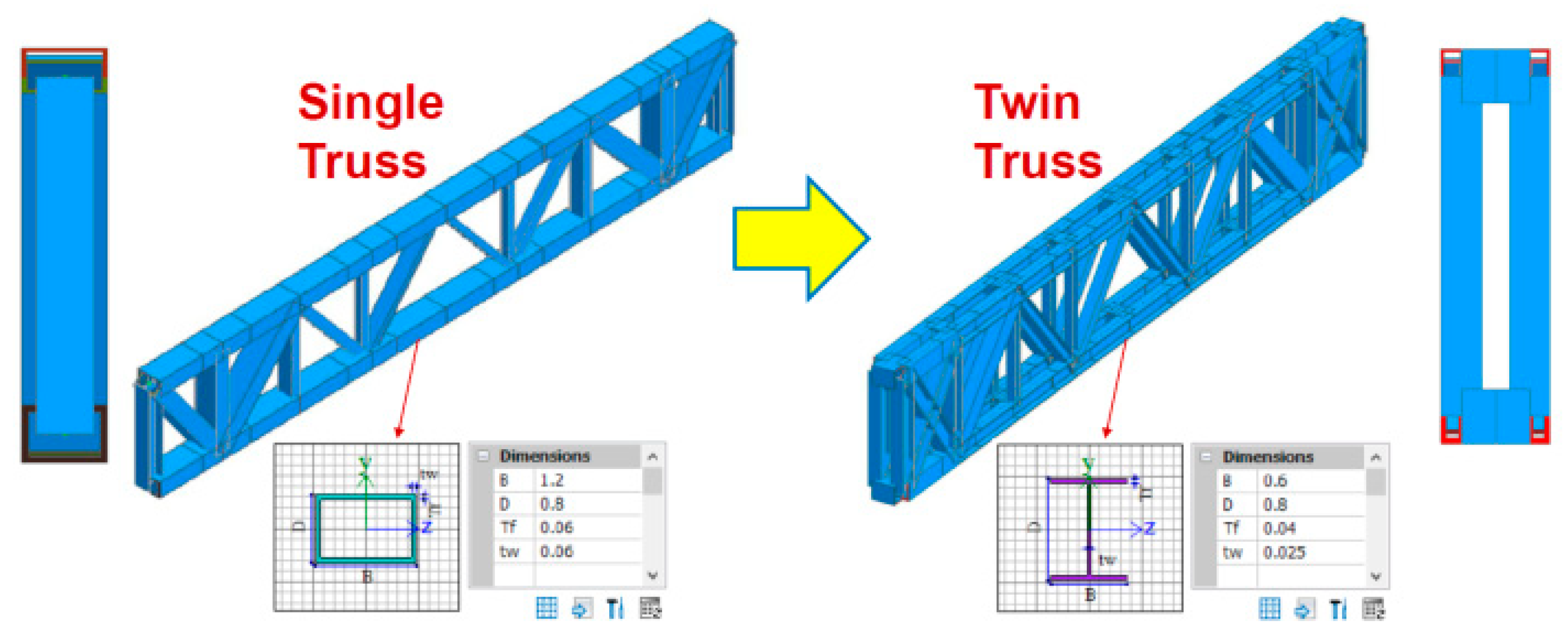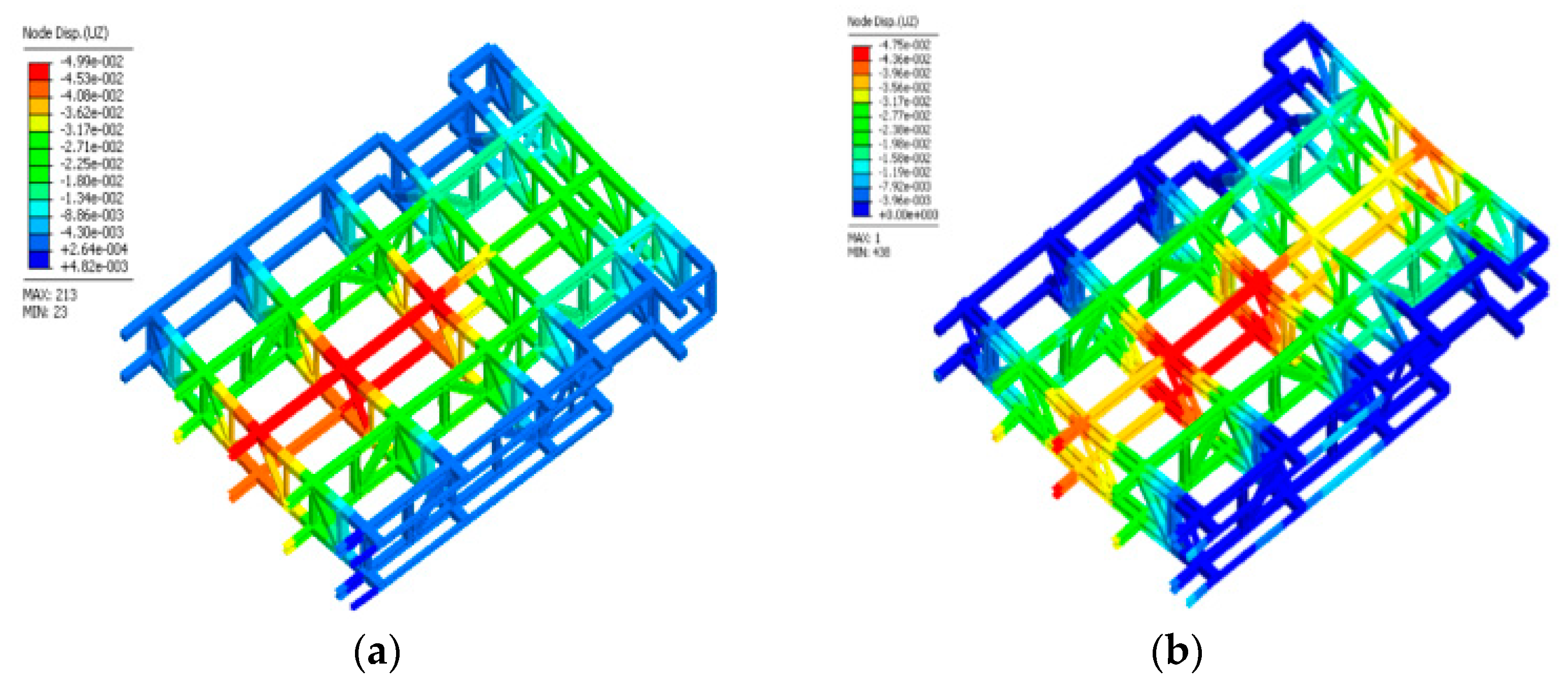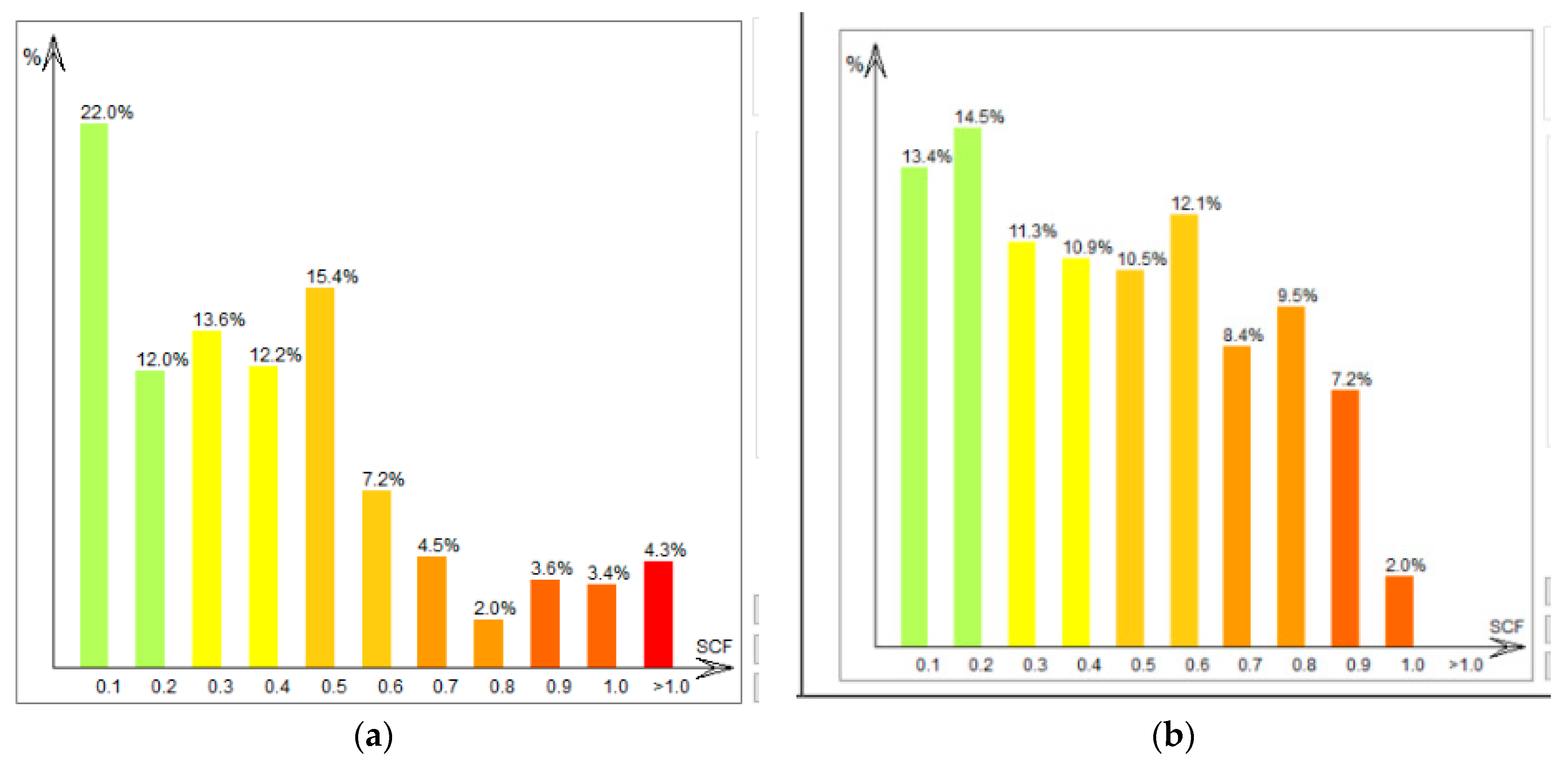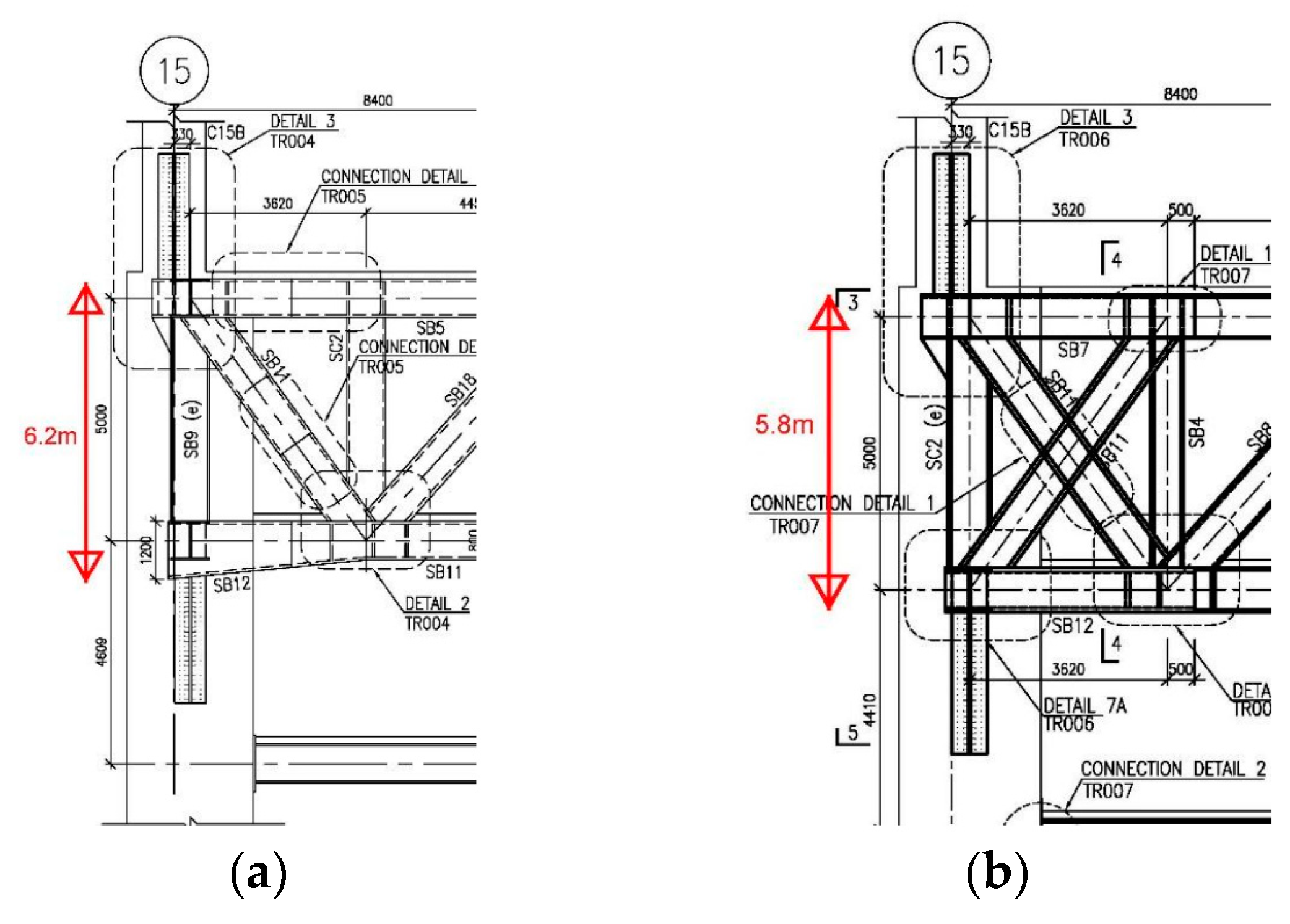Design and Construction of High-Performance Long-Span Steel Transfer Twin Trusses Applied in One Hospital Building in Hong Kong
Abstract
:1. Introduction
- (1)
- Structural form: It significantly affects the structural performance. The choice of form depends on the factors such as the span length, the height of the structure, and the type of loading it is subjected to. Common forms include trusses, arches, cable-stayed structures, and space frames.
- (2)
- Material selection: Steel is commonly used due to its high strength-to-weight ratio and durability, but other materials such as concrete, timber, and composites can also be used. The material needs to be carefully selected based on the specific requirements of the project.
- (3)
- Design loads: Long-span steel structures are typically subjected to a variety of loadings, including dead loads, live loads, wind loads, and seismic loads. The loads need to be carefully considered and analyzed to ensure that the structure can withstand them safely.
- (4)
- Connections: The connections between different structural elements are critical to the performance of long-span steel structures. The connections need to be designed to transfer loads efficiently and safely, and to accommodate any movements or deformations that may occur.
- (5)
- Fire protection: Long-span steel structures are vulnerable to fire, and adequate fire protection measures need to be put in place to ensure the safety of occupants and the stability of the structure. This may include fire-resistant coatings, fireproofing, and sprinkler systems.
- (6)
- Maintenance: Long-span steel structures require regular maintenance to ensure their continued performance and safety. Maintenance may include inspections, repairs, and replacement of components as necessary. In summary, designing long-spann steel structures requires careful consideration of a range of factors.
2. Second-Order Direct Analysis
3. Steel Truss Design Optimization
3.1. Steel Truss Schemes
3.2. Steel Section and Section Type
3.3. Steel Grade
3.4. Joint Connection Details
4. Benefits from Optimal Design
4.1. More Resalable Weight Distribution
4.2. Reduction of Steel Truss Self-Steel Weight and the Use of Z Plate
4.3. Uniformed Deflection for All Primary Trusses
- (1)
- For the optimal design, the deflections of Trusses A-A, B-B and C-C, supporting heavy loads from the superstructure, are essentially the same as those of the original design. Their discrepancies are only within 0.9 mm to 2.7 mm (i.e., 1.7–6.2%).
- (2)
- For the optimal design, the deflections between the trusses are close to each other, i.e., 36.7 mm to 47.5 mm with a difference of 10.8 mm. For the original design, the truss deflections vary from 23.9 mm to 50.7 mm with a difference of 26.8 mm. It means that, in the alternative design, the integrity of trusses and the concrete slab are better than that in the original design. That is, the optimal design has better uniformity and compatibility.
- (3)
- The truss deflections are only about half of the code allowable limits, which can fulfil the code deflection requirements.
4.4. Increase of Overall Capacity
4.5. Reduction in Column Reactions
4.6. More Reasonable Overall Utilization
4.7. Time Saving
4.8. Other Advantages
4.8.1. Reduction in Environmental Pollution
4.8.2. Improvement of Construction Quality Control
4.8.3. Construction Productivity Advantages
4.8.4. Increase in Headroom
4.8.5. Reduce Risk of Welder’s Occupation Health
4.8.6. Reduce Risk of Fire
4.8.7. Reduce in Smell Nuisance
4.8.8. Reduce in Traffic Impact
5. Conclusions
Author Contributions
Funding
Data Availability Statement
Conflicts of Interest
References
- Liu, Y.P.; Pan, S.J.; Leung, S.W.K.; Chan, S.L. Design and construction of long-span single-layer dome structures by direct analysis. HKIE Trans. 2018, 25, 29–43. [Google Scholar] [CrossRef]
- Liu, Y.P.; Chan, S.L.; Zhou, Z.H.; So, D.; Yu, R. Second-Order Analysis and Design of Wall-Framed Structures Allowing for Imperfections. Adv. Struct. Eng. 2010, 13, 513–524. [Google Scholar] [CrossRef]
- Su, M.; Cai, Y.; Chen, X.; Young, B. Behaviour of concrete-filled cold-formed high strength steel circular stub columns. Thin Walled Struct. 2020, 157, 107078. [Google Scholar] [CrossRef]
- Cai, Y.; Su, M.; Chen, X.; Young, B. High strength steel square and rectangular tubular stub columns infilled with concrete. J. Constr. Steel Res. 2021, 179, 106536. [Google Scholar] [CrossRef]
- Li, G.C.; Chen, B.W.; Yang, Z.J.; Liu, Y.P.; Feng, Y.H. Experimental and numerical behavior of eccentrically loaded square concrete-filled steel tubular long columns made of high-strength steel and concrete. Thin Walled Struct. 2021, 159, 107289. [Google Scholar] [CrossRef]
- Cai, Y.; Chan, T.M.; Young, B. Chord plastification in high strength steel circular hollow section X-joints: Testing, modelling and strength predictions. Eng. Struct. 2021, 243, 112692. [Google Scholar] [CrossRef]
- Cai, Y.; Chan, T.M.; Young, B. Strength predictions of circular hollow section T-joints of steel grade 1100 MPa. J. Constr. Steel Res. 2022, 188, 107003. [Google Scholar] [CrossRef]
- Chan, S.L.; Liu, Y.P.; Zhou, Z.H. Limitation of effective length method and codified second-order analysis and design. Steel Compos. Struct. 2005, 5, 181–192. [Google Scholar] [CrossRef]
- Code of Practice for the Structural Use of Steel 2011; Buildings Department of the Government of the Hong Kong Special Administrative Region: Hong Kong, China, 2011.
- Chan, C.M.; Zou, X.K. Elastic and Inelastic Drift Performance Optimization for Reinforced Concrete Buildings under Earthquake Loads. Earthq. Eng. Struct. Dyn. 2004, 33, 929–950. [Google Scholar] [CrossRef]
- Zou, X.K.; Chan, C.M. Optimal Seismic Performance-Based Design of Reinforced Concrete Buildings Using Nonlinear Pushover Analysis. Eng. Struct. 2005, 27, 1289–1302. [Google Scholar] [CrossRef]
- Zou, X.K.; Chan, C.M. An Optimal Resizing Technique for Seismic Drift Design of Concrete Buildings Subjected to Response Spectrum and Time History Loadings. Comput. Struct. 2005, 83, 1689–1704. [Google Scholar] [CrossRef]
- Zou, X.K.; Chan, C.M.; Li, G.; Wang, Q. Multiobjective Optimization for Performance-Based Design of Concrete Structures. J. Struct. Eng. 2007, 133, 1462–1474. [Google Scholar] [CrossRef]
- Zou, X.K.; Teng, J.G.; Xia, S.H.; Wong, Y.L. Optimal Performance-Based Seismic Retrofit Design of FRP-confined Concrete Buildings. Compos. Part B Eng. Int. J. 2007, 38, 584–597. [Google Scholar] [CrossRef]
- Zou, X.K.; Wang, Q.; Li, G.; Chan, C.M. Integrated Reliability-Based Seismic Drift Design Optimization of Base-Isolated Concrete Buildings. J. Struct. Eng. 2010, 136, 1282–1295. [Google Scholar] [CrossRef]
- Eurocode 3: Design of Steel Structures—Part 1-1: General Rules and Rules for Buildings; European Committee for Standardization: Brussels, Belgium; European Union: Brussels, Belgium, 2005.
- AISC-LRFD. Specification for Structural Steel Buildings; AISC, Inc.: Chicago, IL, USA, 2010. [Google Scholar]
- GB50017-2017; Standard for Design of Steel Structures. Ministry of Hosing and Urban-Rural Development of PRC: Beijing, China, 2017.
- Chan, S.L.; Zhou, Z.H. Second-order elastic analysis of frames using single imperfect element per member. J. Struct. Eng. 1995, 121, 939–945. [Google Scholar] [CrossRef]
- Chan, S.L.; Gu, J.X. Exact tangent stiffness for imperfect beam-column members. J. Struct. Eng. 2000, 126, 491–493. [Google Scholar] [CrossRef]
- Bai, R.; Liu, S.W.; Liu, Y.P.; Chan, S.L. Direct Analysis of Tapered-I-Section Columns by One-Element-Per-Member Models with The Appropriate Geometric-Imperfections. Eng. Struct. 2019, 183, 907–921. [Google Scholar] [CrossRef]
- Tang, Y.Q.; Chen, W.F.; Liu, Y.P.; Chan, S.L. Consistent co-rotational framework for Euler-Bernoulli and Timoshenko beam-column elements under distributed member loads. Adv. Struct. Eng. 2021, 24, 1847–1858. [Google Scholar] [CrossRef]
- Du, Z.L.; Liu, Y.P.; Chan, S.L. A second-order flexibility-based beam-column element with member imperfection. Eng. Struct. 2017, 143, 410–426. [Google Scholar] [CrossRef]
- NIDA. User’s Manual, Nonlinear Integrated Design and Analysis. NIDA 10.0 HTML Online Documentation. 2018. Available online: http://www.nidacse.com (accessed on 5 May 2018).
- Chan, S.L.; Chui, P.T. Non-Linear Static and Cyclic Analysis of Steel Frames with Semi-Rigid Connections; Elsevier: New York, NY, USA, 2000. [Google Scholar]
- Tang, Y.Q.; Liu, Y.P.; Chan, S.L.; Du, E.F. An innovative co-rotational pointwise equilibrating polynomial element based on Timoshenko beam theory for second-order analysis. J. Thin Walled Struct. 2019, 141, 15–27. [Google Scholar] [CrossRef]
- Liu, S.W.; Liu, Y.P.; Chan, S.L. Direct analysis by an arbitrarily-located-plastic-hinge element—Part 1: Planar analysis. J. Constr. Steel Res. 2014, 103, 303–315. [Google Scholar] [CrossRef]
- Liu, Y.P.; Chan, S.L. Second-Order and Advanced Analysis of Structures Allowing for Load and Construction Sequences. Adv. Struct. Eng. 2011, 14, 635–646. [Google Scholar] [CrossRef]










| Buckling Curves (CoPHK [9]) | Used in the Second-Order Direct Analysis |
|---|---|
| a0 | 1/550 |
| a | 1/500 |
| b | 1/400 |
| c | 1/300 |
| d | 1/200 |
| Section Type | Original Design | Optimal Design | ||
|---|---|---|---|---|
| Types % | Types % | |||
| Box | 17 | 81% | 6 | 25% |
| H-Section | 4 | 19% | 18 | 75% |
| Total | 21 | 24 | ||
| Steel Grade | Original Design (Ton) | Optimal Design (Ton) | ||
|---|---|---|---|---|
| S460 | 1459 | 72% | 955 | 61% |
| S355 | 578 | 28% | 801 | 39% |
| Total | 2037 | 100% | 1756 | 100% |
| Self-Weight (Ton) | Original Scheme | Optimal Scheme | ||
|---|---|---|---|---|
| Tonnage | Ratio = W/Total | Tonnage | Ratio = W/Total | |
| S460 weight—WS460 | 1459 | 72% | 955 | 61% |
| S355 weight—WS355 | 578 | 28% | 801 | 39% |
| Z-pate weight—WZ-plate | 1421 | 70% | 748 | 43% |
| Total weight | 2037 | 100% | 1756 | 100% |
| Truss | Span | Limit (Span/360) | Deflection (Original Design) | Deflection (Optimal Design) |
|---|---|---|---|---|
| A-A | 32.9 m | 91.3 mm | 43.3 mm | 40.6 mm |
| B-B | 32.9 m | 91.3 mm | 50.7 mm | 47.5 mm |
| C-C | 32.9 m | 91.3 mm | 50.5 mm | 46.6 mm |
| C1-C1 | 28.3 m | 78.6 mm | 31.5 mm | 37.5 mm |
| D1-D1 | 28.3 m | 78.6 mm | 24.1 mm | 36.7 mm |
| E1-E1 | 33.6 m | 93.3 mm | 23.9 mm | 42.0 mm |
| Original Design | Optimal Design | Difference | |
|---|---|---|---|
| Fz′ (kN) | Fz (kN) | (Fz − Fz′)/Fz (%) | |
| Vertical Load (Dead+SDL+Finishes) | 354,632 | 351,751 | −0.81 |
| Live Load | 133,398 | 127,855 | −4.16 |
| Thickness of Plate (mm) | Weld Volume per mm (mm3/mm) | Difference (%) | |
|---|---|---|---|
| Original Design | 80 | 3200 | - |
| Optimal Design | 60 | 1800 | −43.75 |
Disclaimer/Publisher’s Note: The statements, opinions and data contained in all publications are solely those of the individual author(s) and contributor(s) and not of MDPI and/or the editor(s). MDPI and/or the editor(s) disclaim responsibility for any injury to people or property resulting from any ideas, methods, instructions or products referred to in the content. |
© 2023 by the authors. Licensee MDPI, Basel, Switzerland. This article is an open access article distributed under the terms and conditions of the Creative Commons Attribution (CC BY) license (https://creativecommons.org/licenses/by/4.0/).
Share and Cite
Zou, X.-K.; Zhang, Y.; Liu, Y.-P.; Shi, L.-C.; Kan, D. Design and Construction of High-Performance Long-Span Steel Transfer Twin Trusses Applied in One Hospital Building in Hong Kong. Buildings 2023, 13, 751. https://doi.org/10.3390/buildings13030751
Zou X-K, Zhang Y, Liu Y-P, Shi L-C, Kan D. Design and Construction of High-Performance Long-Span Steel Transfer Twin Trusses Applied in One Hospital Building in Hong Kong. Buildings. 2023; 13(3):751. https://doi.org/10.3390/buildings13030751
Chicago/Turabian StyleZou, Xiao-Kang, Yi Zhang, Yao-Peng Liu, Liang-Cheng Shi, and Daniel Kan. 2023. "Design and Construction of High-Performance Long-Span Steel Transfer Twin Trusses Applied in One Hospital Building in Hong Kong" Buildings 13, no. 3: 751. https://doi.org/10.3390/buildings13030751
APA StyleZou, X.-K., Zhang, Y., Liu, Y.-P., Shi, L.-C., & Kan, D. (2023). Design and Construction of High-Performance Long-Span Steel Transfer Twin Trusses Applied in One Hospital Building in Hong Kong. Buildings, 13(3), 751. https://doi.org/10.3390/buildings13030751








